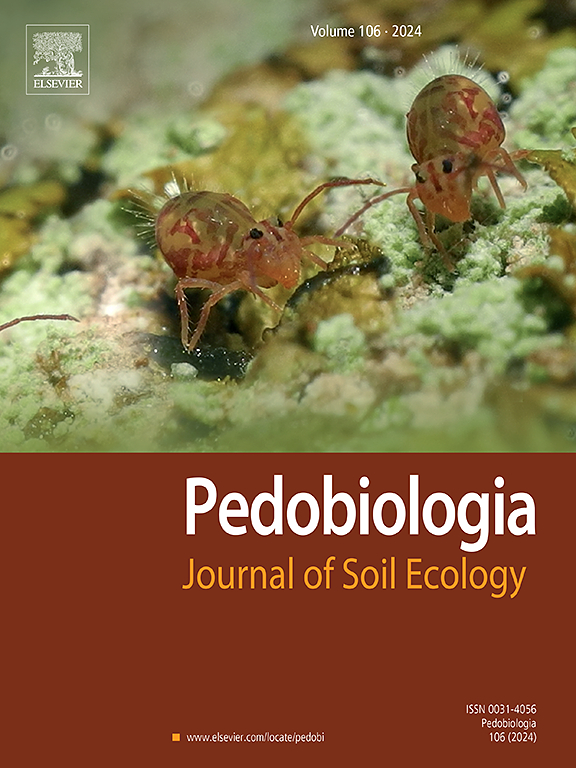Bacterial assemblies in acidic dryland vs. paddy soils across depth profiles in southern China's red soil region
IF 2
3区 农林科学
Q3 ECOLOGY
引用次数: 0
Abstract
Red soils in China are essential for food security, ecological balance, and rural development. Red soil's varied microbial populations help maintain soil health, cycle nutrients, and sustain ecosystems. The variation in bacterial community assembly and distribution with soil depth in acidic dryland and paddy soils is unknown. We sampled dryland and paddy soil profiles from nearby farms in southern China's red soil region. Five soil layers (0–20 cm, 20–40 cm, 40–60 cm, 60–80 cm, 80–100 cm) were taken from a 1-meter soil profile at Yichun, Jiangxi, China. In paddy soils, ammonium nitrogen, available iron, and soil organic matter (SOM) were greater than in dryland soils. While both soil types showed considerable variation in diversity indices (Chao1, Sobs, PD) over the soil profile, paddy soils showed a more wave-like pattern in microbial diversity indicators. Dryland soils had higher relative abundances of Actinobacteriota (3.6–7.3 %) and GAL15 (1.3–8.6 %), while paddy soils had Bacteroidota (3.9–9.2 %), Desulfobacterota (4.2–7.7 %), and Nitrospirota (2.1–12.7 %). Acidobacteriota (29.5–59.1 %), Chloroflexi (6.3–30.9 %), and Proteobacteria (7.5–21.5 %) predominated at both soil types. Taxonomic alterations in Acidobacteriota, Chloroflexi, and Proteobacteria highlighted how microbial communities adapted to dryland vs paddy soils. The assembly of bacterial communities was mostly stochastic, with varied dispersion and assembly dynamics across soil types and depths. Network analysis showed that paddy soils had more complicated interspecies relationships than dryland soils, with a greater average clustering coefficient and lower modularity. Drylands had higher biosynthetic and metabolic activity, especially amino acid metabolism and secondary metabolite production, whereas paddy soils had higher energy metabolism. This research emphasizes how land use affects soil physicochemical properties and microbiological populations. Microbial profiles and functional adaptations of dryland and paddy soils provide soil management techniques to optimize soil health and production in diverse agricultural systems.
中国南方红壤区酸性旱地与水稻土的细菌组合
在中国,红壤对粮食安全、生态平衡和农村发展至关重要。红壤中各种各样的微生物种群有助于保持土壤健康,循环养分,维持生态系统。酸性旱地和水田土壤细菌群落组合和分布随土壤深度的变化尚不清楚。我们从中国南方红壤地区附近的农场取样了旱地和水稻土剖面。在江西宜春1米土壤剖面上采集了5个土层(0 ~ 20 cm、20 ~ 40 cm、40 ~ 60 cm、60 ~ 80 cm、80 ~ 100 cm)。水稻土的铵态氮、速效铁和土壤有机质(SOM)均高于旱地土壤。两种土壤类型的微生物多样性指数(Chao1, Sobs, PD)在土壤剖面上均表现出较大的变化,而水稻土的微生物多样性指数表现出更大的波浪形变化。旱地土壤中放线菌门(3.6 ~ 7.3 %)和GAL15(1.3 ~ 8.6 %)的相对丰度较高,而水稻土壤中拟杆菌门(3.9 ~ 9.2 %)、脱硫菌门(4.2 ~ 7.7 %)和亚硝基螺旋体门(2.1 ~ 12.7 %)的相对丰度较高。酸性菌群(29.5 ~ 59.1 %)、氯菌群(6.3 ~ 30.9 %)和变形菌群(7.5 ~ 21.5 %)在两种土壤类型中均占主导地位。酸菌门、绿菌门和变形菌门的分类变化突出了微生物群落如何适应旱地与水稻土。细菌群落的聚集主要是随机的,在不同土壤类型和深度上具有不同的分散和聚集动态。网络分析表明,水田土的种间关系比旱地土复杂,平均聚类系数大,模块化程度低。旱地具有较高的生物合成和代谢活性,特别是氨基酸代谢和次生代谢物的产生,而水稻土具有较高的能量代谢。本研究强调土地利用对土壤理化性质和微生物种群的影响。旱地和水稻土的微生物特征和功能适应性为在不同农业系统中优化土壤健康和生产提供了土壤管理技术。
本文章由计算机程序翻译,如有差异,请以英文原文为准。
求助全文
约1分钟内获得全文
求助全文
来源期刊

Pedobiologia
环境科学-生态学
CiteScore
4.20
自引率
8.70%
发文量
38
审稿时长
64 days
期刊介绍:
Pedobiologia publishes peer reviewed articles describing original work in the field of soil ecology, which includes the study of soil organisms and their interactions with factors in their biotic and abiotic environments.
Analysis of biological structures, interactions, functions, and processes in soil is fundamental for understanding the dynamical nature of terrestrial ecosystems, a prerequisite for appropriate soil management. The scope of this journal consists of fundamental and applied aspects of soil ecology; key focal points include interactions among organisms in soil, organismal controls on soil processes, causes and consequences of soil biodiversity, and aboveground-belowground interactions.
We publish:
original research that tests clearly defined hypotheses addressing topics of current interest in soil ecology (including studies demonstrating nonsignificant effects);
descriptions of novel methodological approaches, or evaluations of current approaches, that address a clear need in soil ecology research;
innovative syntheses of the soil ecology literature, including metaanalyses, topical in depth reviews and short opinion/perspective pieces, and descriptions of original conceptual frameworks; and
short notes reporting novel observations of ecological significance.
 求助内容:
求助内容: 应助结果提醒方式:
应助结果提醒方式:


